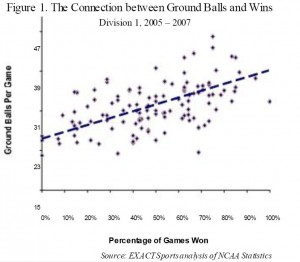I decided to have a little fun and spend some time analyzing data on top collegiate lacrosse players. Major League Lacrosse partnered with us to provide profiles on top players under consideration for their draft. For those who know me, it’s hard to keep my hands off of a treasure trove of data. In this case, quantifiable behavioral information (e.g., competitiveness, confidence, “mental toughness”, training attitudes, etc.), cognitive information (e.g., decision speed, reaction time, concentration, etc.), and physical data (e.g., speed, strength, etc.). From our work, we had a complete picture of each athlete.
Enter The Nation's Largest Prospect Database
Connect with thousands of college coaches across the U.S. and get evaluated for collegiate athletics!
With all that information, I first wanted to ask the most important question: what is a ground ball even worth? In lacrosse, winning the ground ball battle is often what determines the winner of the game. Ground balls are when the ball is loose on the ground and players scoop it up. It's all about possession. The question I was curious about was: a) we know that ground balls are important, but how important?, and b) aside from sheer scooping skill, what are some of the raw ingredients that a lacrosse player should have to help him or her use these skills in the first place?
Here's what I found:
In Division 1 College Men's Lacrosse, a team that picks up just 3 more ground balls per game will win one more game over the course of a 15-game season. And here's some anecdotal support from an article in The Official College Sports Network (OCSN) on May 26, 2006:
One of the goals of the Virginia coaching staff every game is winning the ground ball battle. Last season the Cavaliers were exceptional and averaged 44.8 ground balls per game, up seven from the year before, and almost six more than the opposition. They also won the ground ball war in 11 of 15 games. This year's group of Cavaliers have done their best Brooks Robinson impersonation, sucking up ground balls at a nation-leading rate of 48.9 p er game.
When most teams are earning between 30 and 40 ground balls per game, seeing the Virginia Men's Lacrosse team pick up close to 50 is remarkable. And we all know how successful the Virginia Men's Lacrosse program has been...
So here's where I think it gets interesting. Looking at players' pure running speed, I tapped into our player development database and did some preliminary investigative work. In professional lacrosse, I found that for every 5%-6% increase in a player's explosive speed, they increased the number of ground balls they picked up by 2 per game. In collegiate lacrosse, I found that every 7% to 8% increase in explosive speed yielded 2 more ground balls per game. While I give a word of caution that at the end of the day you can only pick up a finite number of balls (games don't last forever!), and that a lot depends on the quality of opponent, the quality of the field, etc., I think this early analysis is pretty valuable. And I guess maybe intuitive, now that it's all laid out to see. Explosive speed counts. A lot.
Similarly, I did another analysis looking at resistance to mental fatigue. Again, I drew on our work with the top men's collegiate lacrosse players. Here's what I found: Players who were 50% or more accurate in their recall of information after performing arduous mental tasks acquired, on average, 1 more ground ball per game. Lacrosse players: not only do physical training and skills, such as speed, matter for doing well. So do your mental skills!

